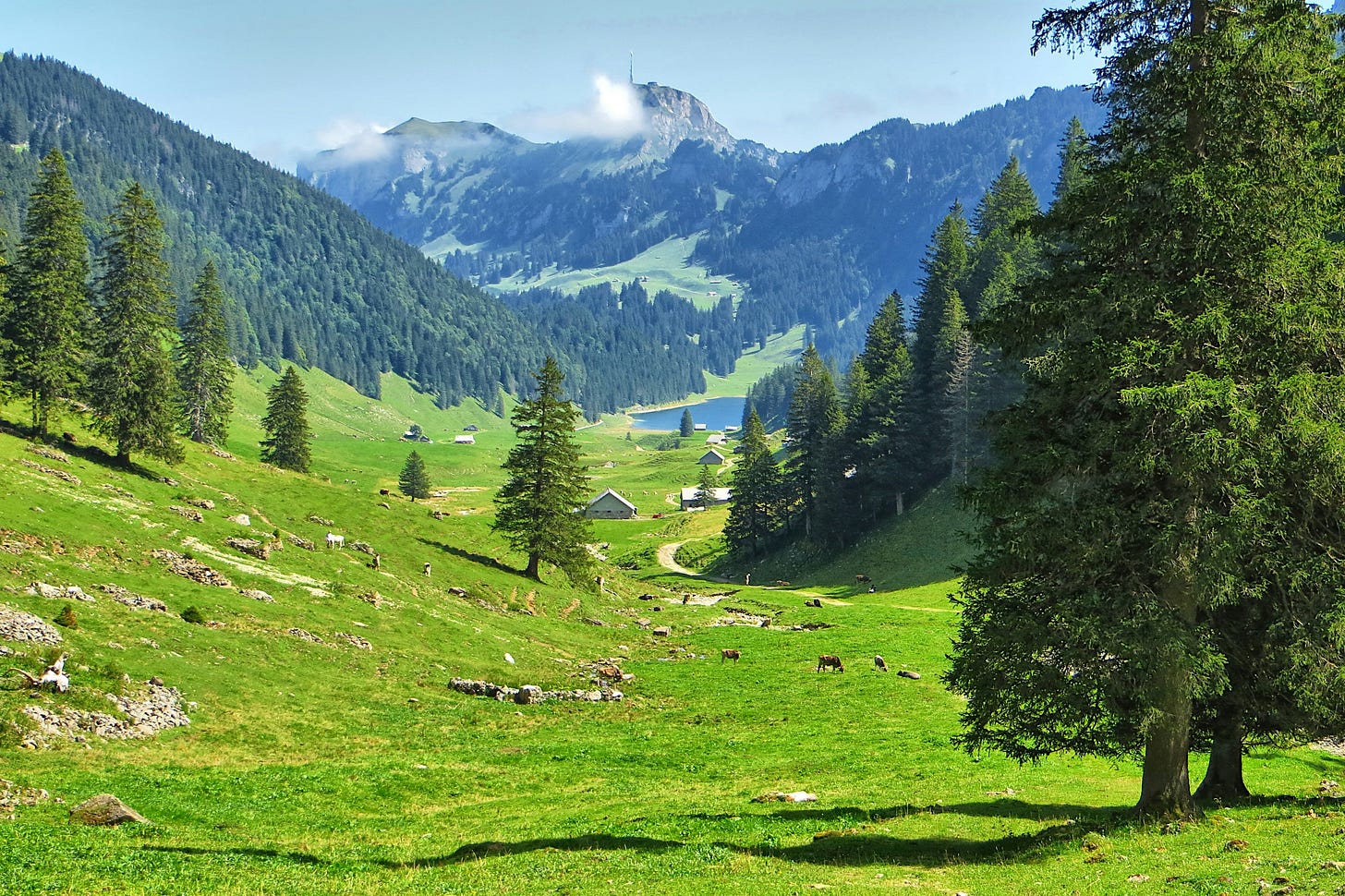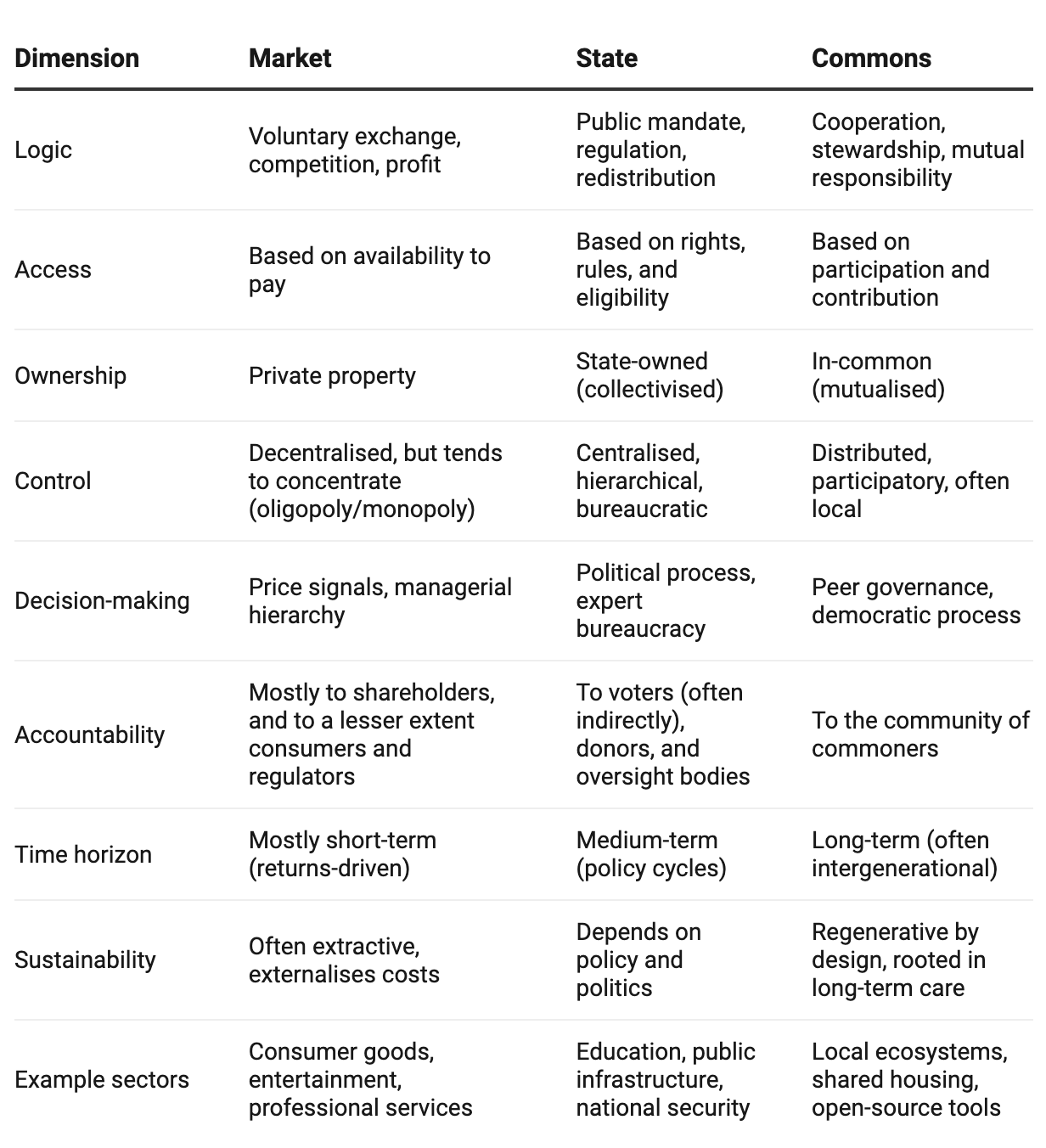What Is the Commons—And Why Does It Matter Today?
Part 2 of our Sunday launch series introducing the Commons.

Tl;dr: For historical and cultural reasons, the Commons has remained largely overlooked or misunderstood. But today, it’s more important than ever to restore it as a vital third mode of provisioning—one that complements and moderates both markets and governments.
Last week, we launched our first Sunday series exploring the Commons as a practical, community-led alternative for meeting shared needs. If you missed Part 1—which examined why traditional institutions struggle to respond to today’s overlapping crises—you can read it here.
A Misunderstood Legacy
If the Commons is such a compelling alternative, why is it still so marginal in public discourse?
Ask around, and you’ll likely get one of three reactions:
“The what?”—from those who’ve never encountered the term.
“That old hippie idea?”—from those who associate it with 60s idealism and dreamy utopias.
“Ah yes, the tragedy.”—from those trained in economics or political science.
Each of these reactions is understandable. And each reflects a different kind of misunderstanding or forgetting. By the end of this article, we hope to see why these responses are normal—and why it’s time to leave them behind.
A Brief History of the Commons
For most of human history, the Commons was the central way that communities organised to meet their needs.
Forests, rivers, fisheries, grazing lands, and many other essential resources were held ‘in-common’—not as private property or state assets, but as shared wealth stewarded by and for a community. In many indigenous traditions around the world, relationships to land, water, plants, and animals were reverential and carried a spiritual dimension. Nature was kin to be respected and cared for, not a commodity to be exploited and processed.
But with the combined rise of capitalism and the modern nation-state, this came to an abrupt end. Beginning in Europe and propagating through colonial expansion, commons were systematically enclosed, marginalised, or dismantled. Land was fenced, forests logged, waterways diverted, and entire communities displaced. Local customs were replaced by legal ownership structures that favoured private gain. And rights that were honoured for generations were revoked or erased.
This process was not accidental.
It served to free up land, labour, and resources for commercial enterprise and imperial ambitions. Commons were seen as obstacles to economic growth and the consolidation of state power. They had to be removed, or at least made insignificant. And so, in many places around the world, the practice of commoning was violently pushed aside and gradually faded from view.
Fast forward to 1968, when a six-page essay by biologist Garrett Hardin, titled The Tragedy of the Commons, seemed to put the final nail in the coffin.
Using a theoretical scenario and principles from game theory, he argued that individuals with open access to a shared resource would inevitably overuse and destroy it—unless it was brought under private ownership or state control. The story spread like wildfire. For decades, it gave policymakers, economists, and corporate interests an academically-sanctioned rationale for enclosure: if communities could not be trusted to manage common wealth, better to nationalise or—preferably—privatise it.
The political and economic shifts of the 1970s and 1980s further accelerated the global expansion of capital flows and markets. Deregulation, privatisation, and structural adjustment were implemented across much of the world, along with a new, stylised—if ridiculous—model of the human as an isolated individual motivated only by rational self-interest. Community provisioning came to be seen as naïve, inefficient, or even dangerously utopian.
But just when the Commons seemed consigned to history, a quiet resurgence began—first intellectually, then practically (more on that in Part 4).
The intellectual turning point came in 1990, when political scientist Elinor Ostrom published Governing the Commons. Drawing on decades of fieldwork, she meticulously documented how communities around the world had long governed natural resources—from alpine meadows to coastal fisheries—using self-made rules, peer monitoring, and institutions of their own design. Her work revealed that commons were not only possible, but in many cases more sustainable, resilient, and adaptive than comparative modes of market or state provisioning.
Her work gained traction across academic disciplines, and, in a moment of stark vindication, she became the first woman to win the Nobel Memorial Prize in Economic Sciences in 2009—just when global markets and national governments had both been brought to their knees.
Defining the Commons: A Living Social Practice
So what exactly is, and makes, a commons?
At its core, a commons consists of three interdependent elements:
A shared resource (physical or immaterial);
A community of people who jointly use and manage that resource;
A set of rules and norms developed and enforced by that community to ensure fair access, responsible use, and long-term stewardship.
Commons can apply to a wide variety of resources. Some are physical, such as natural ecosystems, farmland, housing, or energy infrastructure. Others are immaterial (or intangible): knowledge and culture, data and software, systems of care, and even forms of money.
But in all cases, what makes something a commons is not the resource itself. What matters is the relationships, practices, and agreements that emerge around its stewardship—with the community at its centre. Rather than a place or a “thing”, a commons is a living social system for governing the use of shared wealth.
Garett Hardin’s tragedy, then, was a mischaracterisation. By focusing solely on the resource and assuming unregulated access, he described not a commons but a “free-for-all”: an ungoverned, law-of-the-jungle space where cold self-interest reigns supreme until the resource is decimated or destroyed. But a true commons includes a dedicated community that collectively defines, monitors, and enforces rules to ensure long-term sustainability—through shared responsibility and accountability.
In this sense, “the Commons” may be better understood in its verb form, ‘commoning’: an ongoing process of collective care and co-creation, rather than a static structure. It is a living social practice based on active participation, mutual commitment, and relational trust.
The etymology of the word itself hints at this dynamic: political thinker Alain Lipietz traced it back to the Norman word ‘commun’ (with roots in the Latin word ‘munus’), which means both ‘gift’ and ‘counter-gift’. Thus a commons always implies a reciprocal relationship—with a shared duty to contribute and give back.
Because each commons is shaped by its specific context, no two look exactly the same. The nature of the resource, the history and needs of the community, the cultural norms and tools available—all of these factors influence how a particular commons takes form. And because commons emerge from lived experience, they tend to evolve gradually through practice rather than design.
This flexibility makes commons both resilient and highly adaptable. Without a fixed blueprint, they can be found almost anywhere in the world. Some fail; others flourish. Still, successful commons tend to share certain enabling conditions, many of which Ostrom summarised into eight design principles. They include clearly-defined boundaries, local autonomy and governance, collective peer monitoring, and accessible mechanisms for conflict resolution.
Common(s) Myths
Despite all this, the Commons remains widely misunderstood. To avoid further confusion, it may help to spell out more clearly what it is not.
Not anti-state, but sceptical of large, centralised bureaucracies that disempower communities and impose uniformity from above and afar. In practice, many commons complement public services and work in partnership with supportive local government. The key principle here is subsidiarity: decisions should be made as close to—and by—those affected as possible.
Not anti-market or anti-money, but critical of extractive corporate practices and financialised economies that undermine genuine exchange and fuel speculation. Many commons use market tools and forms of money where appropriate—but designed in ways that prioritise circulation and regeneration over accumulation and extraction.
Not anti-profit, but opposed to economic models that rely on continuous growth and expansion to generate short-term profits, often with little regard for real value creation or the social and environmental costs left behind. In a commons, any surplus is re-invested in—and shared by—the community that generated it, while taking care that the resource isn’t depleted.
Not against private property, but resisting enclosure—the process that converts shared wealth into private gain, excluding others from access and benefit.
Not ideological or partisan, but pragmatic and capable of transcending traditional left-right divides. The Commons enables thriving small businesses and decentralised innovation (which resonates with conservatives); practices fairness and pre-distribution by design (which appeals to the left); favours localised supply chains and ecological stewardship (which greens value); and reduces dependence on centralised state bureaucracies (which libertarians welcome).
Not a fixed institution, but a living social practice that is diverse, adaptable, and constantly evolving.
These distinctions matter. The Commons should not be seen as an ideological countersystem or some abstract utopia. It is a pragmatic, time-tested approach to provisioning that allows communities to take initiative, assume responsibility, and share in the benefits.
Comparing Provisioning Modes: Market, State, and Commons
As we have seen, there are three major modes of provisioning—that is, ways we organise to ensure our needs are met:
The Market, where access is mediated through prices and money;
The State, where access is allocated through law, bureaucracy, and entitlements;
The Commons, where access is guided by community relationships and shared rules.
Note: for this analysis we set aside the Household—one of the oldest institutions of provisioning—due to its naturally limited scale.
Each mode has distinct logics, structures, and outcomes. To better understand what makes the Commons different, let’s see how they compare.
Each mode brings both strengths and important limitations.
Markets are dynamic and highly efficient at facilitating exchange and innovation at scale, without the need for central planning. But they also tend to be extractive, concentrate wealth, and overlook the social and environmental damage they may cause—unless explicitly regulated.
States can provide universal services, redistribute resources to reduce inequality, and offer legal protections that foster stability. But they are often slow to adapt, operate through distant and convoluted bureaucracies, and remain vulnerable to political inertia or capture.
Commons enable communities to meet needs directly, are highly adaptable to local conditions, and promote reciprocity and responsible use. But they also require strong and sustained participation, local capacity, and do not scale in the same way as markets or governments.
While all three modes can, in principle, be applied across many domains, certain sectors tend to align more naturally with particular logics. Crucially, these modes need not compete. They can co-exist, interact with, and even support one another in hybrid configurations. The key is to find the right balance between them, drawing on each one’s strengths while buffering their respective weaknesses.
Conclusion: Why the Commons Matters Now
In today’s world, markets dominate most aspects of life. Where markets fail, we turn to government. We have come to rely so heavily on these two modes that we’ve forgotten the third.
The Commons, though much older than both, remains marginalised and largely unrecognised. This imbalance has contributed to many of the systemic failures we see today, from ecological overshoot and extreme inequality to the gradual erosion of democratic agency.
The Commons can fill critical gaps left behind by the Market-State binary. But we need to realise that no single mode can, on its own, respond to the scale or complexity of today’s overlapping crises. In my view, it is only when markets, governments, and commons work together—each in service of people and planet—that a truly healthy and resilient society can emerge. It’s therefore imperative that we strengthen the Commons and restore it as a vital third pillar—not to reject the other two, but to complement and moderate the excesses of both.
The beauty of the Commons is that it’s a peaceful mode of collective action, rooted in community initiative and voluntary participation. By inviting us to reimagine provisioning as something communities can actively do—not just passively receive—it inspires us to take action.
And it already exists all around us.
Once we recognise the principles of commoning, we start to see them everywhere: neighbours sharing childcare or tending a community garden. Local repair cafés and tool libraries. Digital communities building and maintaining open-source projects on the Internet.
Chances are, you’re already part of a commons. You just haven’t called it that (yet).
Before You Go…
This Substack is written by and for people who want to reimagine the way we meet our needs—with practical, concrete actions that have real-world application. We are part of a growing alliance of individuals, communities, and organisations determined to seed and grow the Commons across different domains.
If this resonates with you:
Subscribe to follow along
Share this article with others
Reach out to collaborate, contribute a guest post, or just say hello
Up next (Sunday, 21st September): we’ll explore the diverse tools that help commons thrive—from economic and financial mechanisms to governance models, legal structures, social norms, cultural practices, and digital infrastructure.
Make sure to subscribe so Part 3 lands straight in your inbox!




